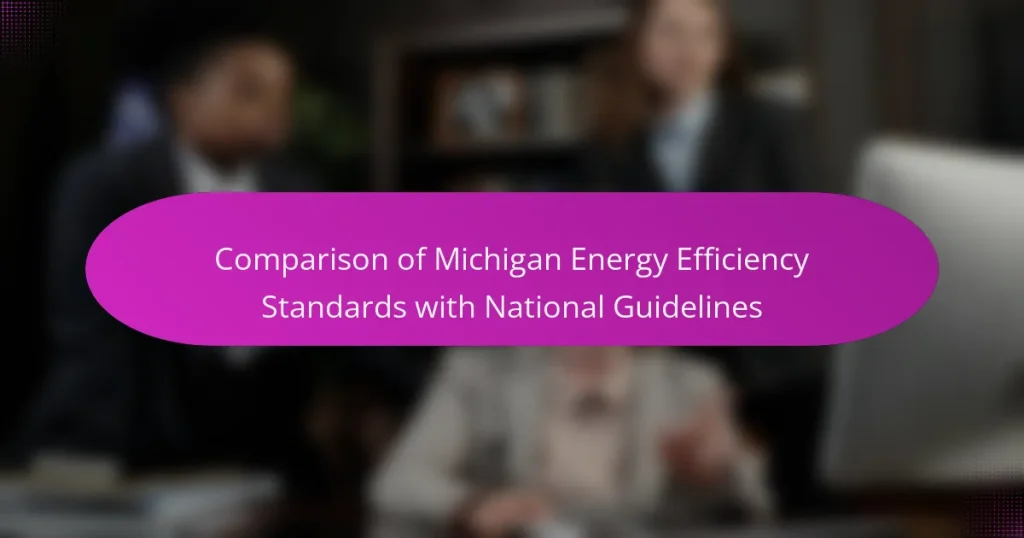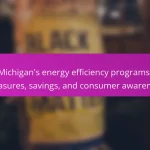
What are Michigan Energy Efficiency Standards?
Michigan Energy Efficiency Standards are regulations designed to promote energy conservation within the state. These standards set specific efficiency requirements for various appliances, equipment, and buildings. They aim to reduce energy consumption, lower utility costs, and minimize environmental impact. Michigan’s standards align with national guidelines but also include unique state-specific provisions. For example, the standards cover residential, commercial, and industrial sectors. They are enforced by the Michigan Public Service Commission. Compliance with these standards is mandatory for manufacturers and service providers operating in Michigan.
How do Michigan Energy Efficiency Standards compare to national guidelines?
Michigan Energy Efficiency Standards are generally more stringent than national guidelines. The state has implemented specific measures that exceed federal requirements. For example, Michigan’s energy efficiency programs mandate that utilities achieve energy savings targets of 1% annually. In contrast, national guidelines set by the Department of Energy do not impose such specific state-level targets. Additionally, Michigan’s standards include provisions for comprehensive building codes that align with or surpass national energy codes. These codes are regularly updated to reflect advancements in energy efficiency technology. Overall, Michigan’s approach emphasizes proactive energy conservation compared to the broader federal framework.
What are the key components of Michigan Energy Efficiency Standards?
The key components of Michigan Energy Efficiency Standards include energy savings targets, demand-side management programs, and energy performance standards for appliances. Energy savings targets require utilities to achieve specific reductions in energy consumption. Demand-side management programs focus on optimizing energy use through consumer engagement and incentives. Energy performance standards set minimum efficiency requirements for various appliances and equipment. These components aim to enhance energy efficiency across the state, contributing to reduced energy consumption and lower greenhouse gas emissions. The Michigan Public Service Commission oversees compliance and implementation of these standards, ensuring utilities meet their energy-saving goals.
How are these standards developed and enforced in Michigan?
Energy efficiency standards in Michigan are developed through a collaborative process involving state agencies, stakeholders, and the public. The Michigan Public Service Commission (MPSC) plays a key role in this process. They assess energy efficiency programs and establish regulatory frameworks. Stakeholder input is gathered during public hearings and workshops. This ensures that diverse perspectives are considered.
Enforcement of these standards is conducted by the MPSC and utilities. The MPSC monitors compliance with established regulations. Utilities are required to report their energy savings and program effectiveness. Non-compliance may result in penalties or corrective measures. This structured approach aims to enhance energy efficiency across the state.
Why are energy efficiency standards important?
Energy efficiency standards are important because they help reduce energy consumption and lower utility costs. These standards promote the use of technology that consumes less energy while maintaining performance. According to the U.S. Department of Energy, energy efficiency standards have led to significant savings, estimated at $2 trillion from 1980 to 2018. They also contribute to reducing greenhouse gas emissions, improving air quality, and enhancing energy security. Additionally, energy efficiency standards drive innovation in energy-saving technologies, creating jobs in the energy sector. Overall, they play a critical role in sustainable development and economic growth.
What benefits do energy efficiency standards provide to consumers?
Energy efficiency standards provide consumers with lower utility bills and improved comfort in their homes. These standards require appliances and buildings to use less energy, which directly reduces energy costs. According to the U.S. Department of Energy, energy-efficient appliances can save consumers hundreds of dollars over their lifetime. Additionally, these standards often lead to better quality products that perform more reliably. Energy efficiency also contributes to environmental sustainability by reducing greenhouse gas emissions. This aligns with consumer preferences for eco-friendly products. Overall, energy efficiency standards enhance consumer savings while promoting a healthier environment.
How do energy efficiency standards contribute to environmental sustainability?
Energy efficiency standards contribute to environmental sustainability by reducing energy consumption and greenhouse gas emissions. These standards mandate that appliances and buildings use less energy to perform the same functions. For example, according to the U.S. Department of Energy, energy efficiency standards have saved consumers over $1 trillion since 1987. Lower energy use leads to decreased reliance on fossil fuels, which are significant sources of carbon emissions. Additionally, energy-efficient practices help preserve natural resources and reduce waste. In Michigan, energy efficiency standards align with national guidelines, promoting a more sustainable environment through shared goals.

What are the national energy efficiency guidelines?
National energy efficiency guidelines are standards set to promote energy conservation and efficiency across various sectors. These guidelines are established by the U.S. Department of Energy (DOE) and include regulations for appliances, commercial buildings, and industrial processes. They aim to reduce energy consumption and greenhouse gas emissions.
For example, the Energy Policy Act mandates efficiency standards for appliances like refrigerators and air conditioners. Additionally, the Energy Independence and Security Act emphasizes improvements in energy efficiency for federal buildings. These guidelines are periodically updated to reflect advancements in technology and energy-saving practices.
The implementation of these guidelines has led to significant energy savings. According to the DOE, energy efficiency standards have saved American consumers over $2 trillion since 1987.
How are national energy efficiency guidelines established?
National energy efficiency guidelines are established through a collaborative process involving federal agencies, stakeholders, and experts. The U.S. Department of Energy (DOE) plays a key role in this process. It conducts research and analysis to determine best practices and benchmarks for energy efficiency. Public input is often solicited through comment periods and public meetings. These guidelines are based on data-driven assessments of energy consumption and potential savings. The Energy Policy Act and subsequent legislation provide the framework for these guidelines. This process ensures that the guidelines are relevant and effective in promoting energy efficiency across the nation.
What agencies are responsible for creating and updating these guidelines?
The agencies responsible for creating and updating energy efficiency guidelines include the U.S. Department of Energy (DOE) and the Environmental Protection Agency (EPA). The DOE develops national energy efficiency standards and regulations. The EPA collaborates on energy efficiency programs, particularly those related to environmental impact. Both agencies regularly review and update guidelines to reflect advancements in technology and policy. Their updates ensure compliance with federal mandates and promote energy conservation.
How do national guidelines address different sectors (residential, commercial, industrial)?
National guidelines address different sectors by establishing specific standards tailored for residential, commercial, and industrial applications. For residential sectors, guidelines typically focus on energy efficiency measures like insulation, HVAC systems, and appliances. In commercial sectors, the emphasis is on optimizing energy use in lighting, heating, and cooling systems. Industrial guidelines often prioritize energy management systems and process optimization to enhance overall efficiency.
These guidelines are informed by research indicating that tailored approaches can lead to significant energy savings. For instance, the U.S. Department of Energy reports that energy-efficient practices in commercial buildings can reduce energy use by 30%.
What are the main differences between Michigan and national standards?
Michigan energy efficiency standards differ from national standards in several key areas. Michigan has specific requirements that may exceed those set by national guidelines. For example, Michigan mandates more stringent energy performance criteria for certain appliances. Additionally, the state has unique programs aimed at promoting renewable energy sources. National standards, such as those set by the Department of Energy, provide a baseline but allow states to implement stricter regulations. Furthermore, Michigan’s standards include incentives for energy-saving initiatives that are not always present at the national level. These differences reflect Michigan’s commitment to enhancing energy efficiency and sustainability beyond federal expectations.
What unique attributes exist in Michigan’s standards compared to national guidelines?
Michigan’s energy efficiency standards include unique attributes not found in national guidelines. One significant attribute is the requirement for utility companies to achieve specific energy savings targets. These targets are more stringent in Michigan, mandating a minimum of 1% annual energy savings.
Additionally, Michigan’s standards emphasize the use of demand response programs more than national guidelines. These programs incentivize consumers to reduce energy usage during peak periods.
Another unique aspect is the inclusion of specific provisions for low-income households. Michigan mandates that a portion of energy efficiency funds be allocated to assist these households.
Lastly, Michigan has a unique focus on integrating renewable energy sources within its energy efficiency framework. This approach is less emphasized in national guidelines. These unique attributes reflect Michigan’s commitment to enhancing energy efficiency and promoting sustainable practices.
How do these differences impact energy consumption in Michigan?
Differences in energy efficiency standards between Michigan and national guidelines significantly impact energy consumption in the state. Michigan’s stricter standards lead to reduced energy usage in residential and commercial buildings. For instance, according to the Michigan Public Service Commission, energy efficiency programs saved over 1.4 billion kWh in 2020 alone. This reduction translates to lower utility bills for consumers and decreased demand on the energy grid. Additionally, improved efficiency standards can lead to a decrease in greenhouse gas emissions. Overall, these differences foster a more sustainable energy landscape in Michigan.

What are the implications of the comparison?
The implications of the comparison between Michigan Energy Efficiency Standards and national guidelines include potential policy adjustments. These adjustments may lead to enhanced energy savings in Michigan. Improved standards can result in lower utility bills for consumers. They may also drive investments in energy-efficient technologies. Furthermore, aligning with national guidelines could facilitate compliance with federal regulations. This alignment may improve Michigan’s competitiveness in the energy sector. A comparison can highlight gaps in current standards and identify areas for improvement. Ultimately, this can foster a more sustainable energy future for Michigan.
How does the comparison affect stakeholders in Michigan?
The comparison of Michigan energy efficiency standards with national guidelines affects stakeholders by influencing regulatory compliance and operational costs. Utilities in Michigan must adapt to both state and national standards, impacting their budgeting and investment strategies. Businesses may face increased costs for upgrades to meet stricter efficiency requirements. Consumers could benefit from lower energy bills due to improved efficiency measures. Environmental groups may see this comparison as a way to promote sustainability initiatives. Overall, the comparison shapes the landscape of energy policy and economic implications for all stakeholders involved in Michigan’s energy sector.
What challenges do utility companies face in meeting these standards?
Utility companies face several challenges in meeting energy efficiency standards. Regulatory compliance is complex and varies across jurisdictions. This requires significant administrative resources to track and implement changes. Financial constraints also limit investment in new technologies and infrastructure. Utility companies often struggle to balance cost-effectiveness with the need for upgrades. Additionally, customer engagement is crucial for program success. Many customers may be unaware of available energy efficiency programs. This lack of awareness can hinder participation rates. Finally, evolving technologies and market conditions create uncertainty. Utility companies must continuously adapt to these changes to remain compliant.
How do consumers respond to the differences in energy efficiency standards?
Consumers often show varying responses to differences in energy efficiency standards. Many consumers prefer products that meet higher efficiency standards. This preference is driven by the potential for long-term cost savings on energy bills. Research indicates that 70% of consumers consider energy efficiency an important factor in purchasing decisions. Consumers also tend to trust brands that comply with stricter standards. This trust can lead to increased brand loyalty and higher sales for compliant products. Additionally, some consumers may feel overwhelmed by the complexity of energy ratings. This confusion can lead to indecision or reliance on external advice. Overall, consumer response is influenced by perceived savings, trust in brands, and clarity of information.
What best practices can be adopted from the comparison?
Adopting best practices from the comparison of Michigan Energy Efficiency Standards with National Guidelines includes implementing stringent energy audits. Energy audits identify areas for improvement in energy usage, leading to reduced consumption. Another best practice is enhancing building codes to align with national standards. This ensures that new constructions are energy-efficient from the outset. Additionally, promoting public awareness campaigns about energy efficiency can drive consumer engagement. Educating residents on the benefits of energy-saving measures can increase participation in efficiency programs. Lastly, fostering partnerships between government and private sectors can facilitate the sharing of resources and expertise. Collaboration often leads to more innovative solutions in energy efficiency.
How can Michigan enhance its energy efficiency standards based on national guidelines?
Michigan can enhance its energy efficiency standards by adopting best practices from national guidelines. This includes aligning with the Energy Policy Act and the Energy Independence and Security Act. Implementing rigorous building codes is essential for improving energy performance. Additionally, increasing incentives for energy-efficient technologies can drive adoption. Michigan can also benefit from benchmarking and performance tracking, which are emphasized in national standards. Collaboration with utility companies to promote energy-saving programs is crucial. Lastly, public awareness campaigns can educate residents about energy efficiency benefits. These steps can significantly improve Michigan’s energy efficiency outcomes.
What strategies can consumers implement to maximize energy efficiency?
Consumers can implement several strategies to maximize energy efficiency. First, they should use energy-efficient appliances. These appliances consume less energy, leading to lower utility bills. Second, consumers can improve home insulation. Proper insulation reduces heating and cooling costs significantly. Third, utilizing programmable thermostats helps in managing energy use effectively. These devices adjust temperatures based on occupancy, optimizing energy consumption. Fourth, consumers should conduct regular maintenance on HVAC systems. Well-maintained systems operate more efficiently, reducing energy waste. Additionally, using LED lighting instead of incandescent bulbs can result in substantial energy savings. According to the U.S. Department of Energy, LED bulbs use at least 75% less energy. Finally, consumers can consider renewable energy sources, such as solar panels. These systems reduce reliance on traditional energy sources and lower overall energy costs.
Michigan Energy Efficiency Standards are state regulations aimed at promoting energy conservation across various sectors, including residential, commercial, and industrial. The article compares these standards to national guidelines, highlighting Michigan’s more stringent requirements and unique provisions, such as specific energy savings targets and demand-side management programs. Key components of the standards, their development and enforcement processes, and the implications for stakeholders are discussed, along with the benefits for consumers and the environment. Additionally, the article examines the challenges faced by utility companies and strategies for enhancing energy efficiency in Michigan.


